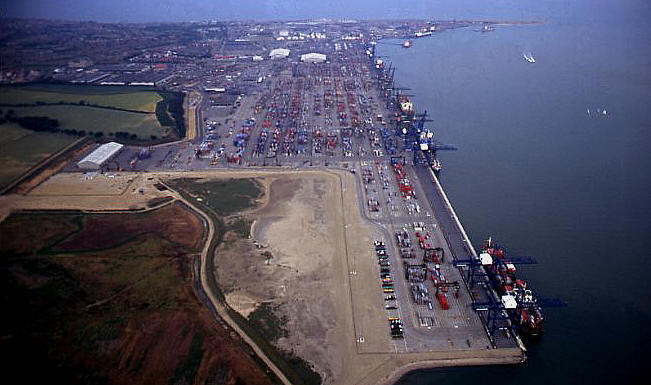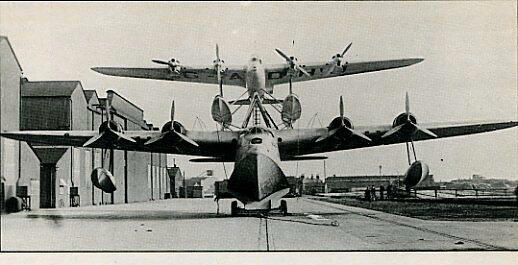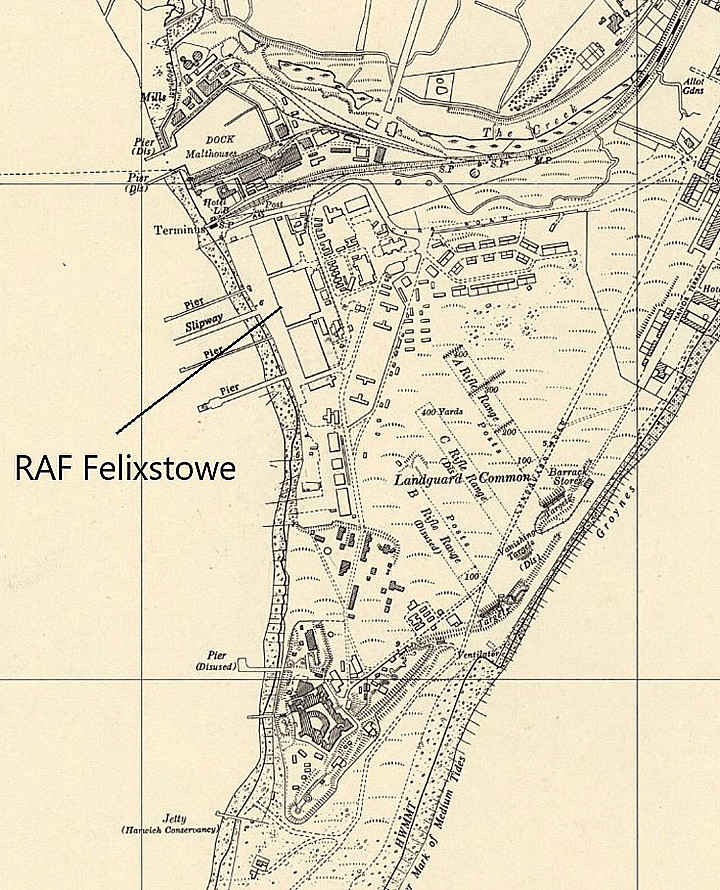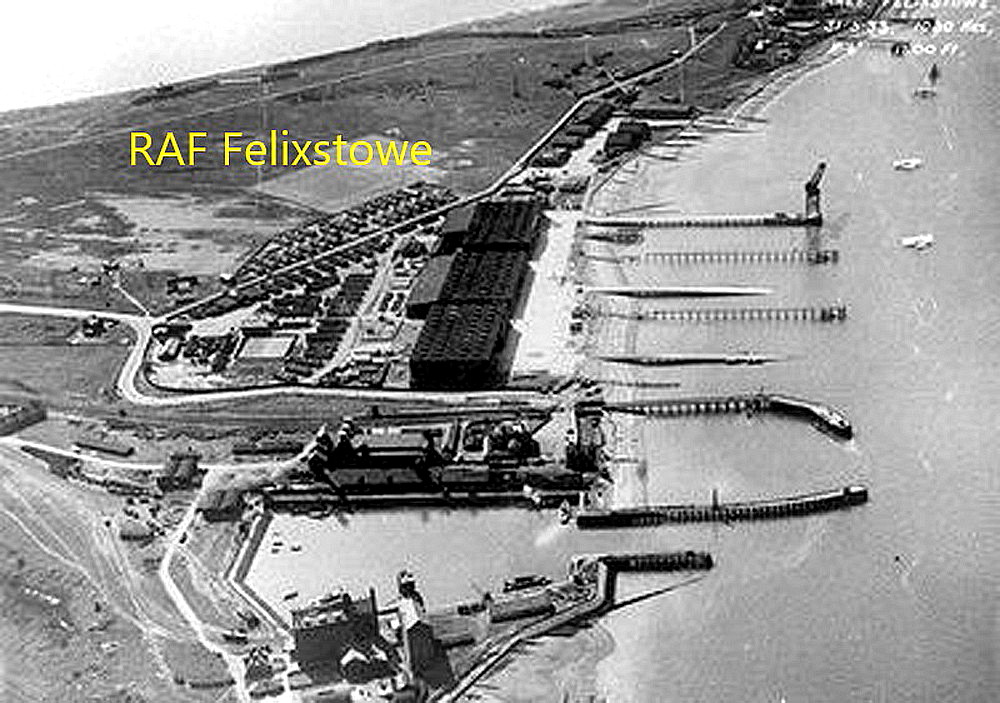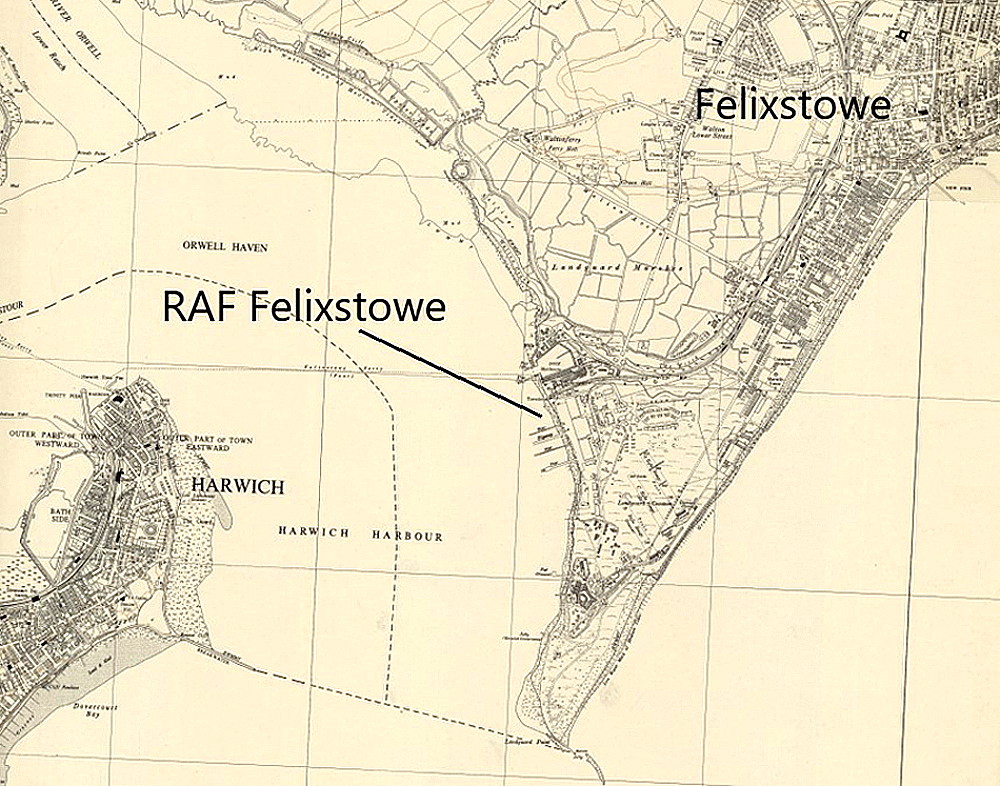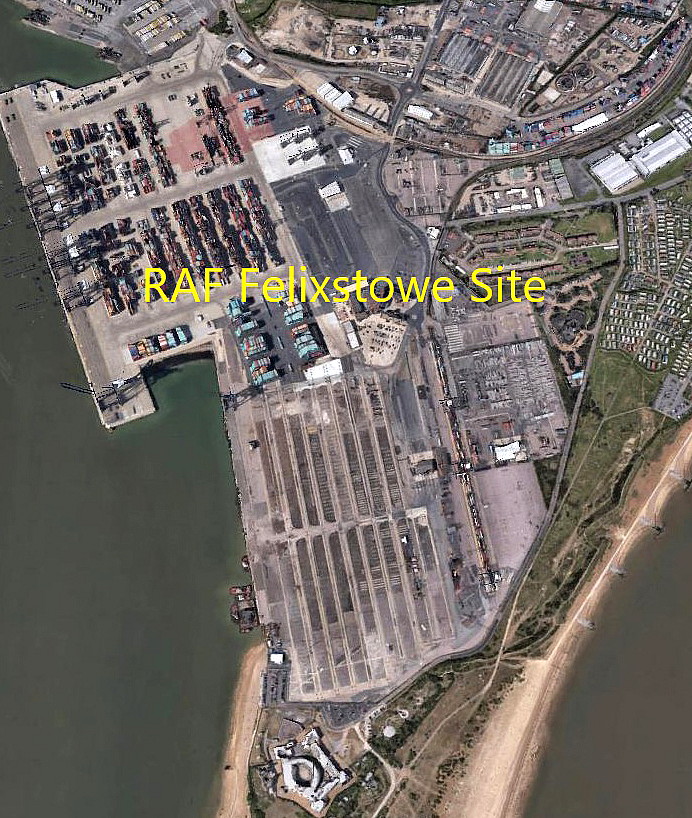Felixstowe flying sites
FELIXSTOWE: Temporary Landing Ground
Operated by: Sir Alan Cobham’s Municipal Aerodrome Campaign
NOTES: FELIXSTOWE was the intended 81st venue for the 1929 Sir Alan Cobham's Municipal Aerodrome Campaign. Starting in May and ending in October one hundred and seven venues were planned to be visited. Mostly in England but with two venues in Wales and seven in Scotland. Experience has taught me to be very wary about assuming he used an established aerodrome, especially one operated by the military. In the end he managed to visit about 95 venues - still a magnificent achievement of course.
The aircraft he used for most of this 'Tour' was the DH61 'Giant Moth' G-AAEV, named 'Youth of Britain'. The punishing schedule he set himself seems astonishing today. See STOCKTON-on-TEES for more information. Without any doubt this 'Tour' did result in several aerodromes/regional airports being commissioned - but not in Felixstowe. See seperate listing - MILL LANE in Felixstowe for more information.
On the 10th July 1935 Sir Alan Cobhams No.1 Tour displayed in/near Felixstowe. Can anybody kindly offer advice regarding the location of these venues?
FELIXSTOWE see also LANDGUARD COMMON
FELIXSTOWE see also MILL LANE
FELIXSTOWE: Military seaplane and flying boat station
Note: Picture by the author.
Military users: WW1: RNAS Coastal seaplane & flying boat station (1913 to 1918)
Experimental Station: RNAS/RAF (1915 to 1919)
Flying boat school: RNAS/RAF (1918 to 1919)
Marine Operations Station: RAF 1918 to ?
Note: The second picture was scanned from the December 1988 edition of Aeroplane Monthly magazine.
THE INTER-WAR YEARS
Note: Base for RAF High-speed Flight in 1930s & base of the MAEE (Marine Aircraft Experimental Station) from 1924 and into the late 1930s. During WW2 also?
Probably the most unusual set of flight test circumstances came about when the Short Mayo 'combo', comprising the Short S.21 Maia (G-ADHK), based on the Short 'C-Class' Empire flying boat, and the Short S.20 Mercury floatplane (G-ADHJ) arrived in March 1938. It was a novel idea, designed to transport air freight for Imperial Airways over very long distances. The idea was that a 'mother' aircraft could carry a smaller aircraft part of the way along the route, then release it to reach its destination. It actually worked very well and several proving flights were undertaken. See the listing for DUNDEE.
But, I was somewhat surprised to learn, the article in Aeroplane Monthly states that the Maia and Mercury were each tested seperately to obtain a Certicate of Airworthiness. Certainly Shorts did a lot of the flight testing, the first airborne seperation being conducted in February from the Shorts factory at BORSTAL near Rochester on the 6th February 1938. However, if this was the case, why are the two pictured joined up? Surely this indicates that some testing was done with the combination in place?
The first long distance flight was from Foynes in Ireland to Boucherville near Quebec in Canada on the 21st July 1938. Without any doubt the project showed a lot of promise, but WW2 intervened - and everything changed.
A MICHAEL T HOLDER GALLERY
WW2: Listed as a RAF station
POST WW2
22 Sqdn arrived with Westland Whirlwinds in 1956 from MARTLESHAM HEATH when this Station was all but closed for flying operations, in a Air-Sea Rescue role. They departed for TANGMERE on the 25th May 1961, the last day of flying from FELIXSTOWE
Location: The RAF Station stood on the banks of the River Orwell estuary directly opposite and N of Harwich Harbour, also, it is said, several piers on seaward side of penisular south of Felixstowe town during WW2 only? I very much doubt this is correct? I think the piers were always in the estuary.
Flying boats especially were moored in the estuary and a 50 ton Titan crane was used to bring them ashore if required. The Station was situated where the container port stands today and three of their hangars served as warehouses. (Until the 1980s at least?). The control tower and officers mess accommodated HM Customs, again until the 1980s at least?
Period of operation: 1913 to 1919. Reopened in 1924 and apparently operational until 1961, (1962 final closure)
Land site area: WW1: 38 acres
Alighting areas: To date research shows aircraft landed and took off both in Harwich harbour, (the Orwell estuary), and in the sea if conditions permitted.
NOTES: After being commissioned on the 5th August 1913 the Station began assembling a collection of seaplanes, or hydro-aeroplanes as they were then known, including: Maurice & Henri Farman types, the Borel monoplane, Short S.41 and the Sopwith Bat-Boat. (See LANDGUARD COMMON for landplane use in that era). Later on in WW1 when the Station was commanded by Cdr. John C Porte, (and under his instigation 1916 to 1918?), the ‘F’ or Felixstowe series of flying boats were developed being constructed by the Station’s own craftsmen and test flown by their own pilots. These were, (in WW1 at least), adaptions of Curtiss designs brought from the USA, with probably the most significant difference being the Rolls-Royce engines?
In 1917 the RNAS very effective ‘spider web’ concept and plan of enemy submarine search and destroy operations probably started from here, centred from the North Hinder light ship. Frequent anti-Zeppelin patrols took place too during 1917 and 1918.
Several attacks by German Gotha bombers and Zeppelin airships caused considerably damage and several fatalities but on one occasion the Zeppelin L-48 was intercepted on the night of 17th June 1917 by a BE-12 flown by Lieut. Watlin and a DH-2 flown by Capt. (later Air Marshall), Saundby. The airship caught fire and crashed into a field at Theberton, (near Leiston), and afterwards known by local people as ‘Zeppelin Field’.
AN AUTOMATIC LANDING SYSTEM
The ‘automatic’ landing system for use in landing in fog on water was developed here during WW1. It comprised a long stick dangling more or less vertically which, coupled to the control stick/elevators, flared the aeroplane into landing with the correct landing attitude on contact with the water! Very brave men developed this technique I would say.
AN EPIC FLIGHT
In 1919 a F-5 Felixstowe flying boat left here for a twenty seven day 3,942km (2,450 mile), tour of Scandinavia to demonstrate the commercial possibilities of flying boats. Amazingly this aircraft suffered no problems or delays throughout the tour - a remarkable achievement at the time.
ANOTHER ERA
It appears the base closed in 1919 when by then it was operated by the RAF. It was reopened in 1924 as the Marine Aircraft Experimental Station. In his book Spitfire's Forgotten Designer Mike Roussel informs us: “This was where the RAF High Speed Flight was formed for the Schneider Trophy race in 1927. However, after the 1927 race, which was held in Venice, the government disbanded the High Speed Flight, partly because of cost but also because there were no serving officers taking part in the races. The High Speed Flight had been formed initially because other competing countries were using military pilots, which was felt to be a disadvantage to the British entries for the Schneider Trophy. The High Speed Flight was later re-formed and was then based at Calshot for the 1929 and 1931 Schneider Trophy races, both won by Britain, which then retained the Schneider Trophy.”
ANOTHER EPIC FLIGHT?
6th Oct 1927: Four RAF Supermarine Southampton flying boats departed for a massive Far East tour covering some 27,000 miles. Initially they routed through the Mediterranean Sea, then onto India and Singapore. Later they visited Hong Kong, Australia and New Zealand before arriving back in Singapore on the 11th December 1928 over one year later. Some trip! I wonder how many bars they visited along the way? Apparently aerial expeditions such as this were called a ‘Cruise’ by the aircrews presumably because were invariably wined and dined at every point along the way?
Once again in my research this information by at least one author does now appear very much mistaken. Without too much doubt the four Southampton flying boats actually departed from MOUNT BATTEN, in Plymouth (DEVON).
AN INTERESTING ASPECT
One other aspect of the history of FELIXSTOWE deserves a mention? During 1945 several captured German seaplane/flying boat types arrived for evaluation. Types like the Arado 196, Blohm & Voss BV 138B, Dornier Do 18 and Do 24, and - to my delight at least, (which I first learnt about in 2008), a floatplane version of the Junkers Ju 52/3W. I had known for many years that at least one Douglas C-47 had been fitted with floats so learning this kind of equalled things up.
RECOMMENDED READING
For a full history it is recommended to read ‘Seaplanes-Felixstowe’ by Gordon Kinsey published by Terence Dalton 1978. This whole episode, (now mainly forgotten?), makes for fascinating reading to anybody in the slightest bit interested in our aviation history.
WHY HERE?
Here is another note I think of interest especially because it was during WW2 that military aeroplanes were ferried across the Atlantic. The first example of this happening, according to Graham Smith, is the Consolidated PBY-4 which crossed from Newfoundland to FELIXSTOWE on the 13th to 15th in July 1939, the flight of 2,450 miles taking 15 hours 30 minutes. Therefore averaging 158mph ground speed. But I would ask, why was FELIXSTOWE the destination?
ANOTHER MEMORY
This is by Dennis Bird, as related in More Tails Of The Fifties, compiled and edited by Peter G Campbell. Published in 1998, here are some excerpts:
"The thrill of one's first flight is never forgotten. I was posted to RAF Felixstowe, which then housed the Marine Aircraft Experimental Establishment (MAEE), and on the 6th July 1950I took to the air for the first time - not from any mundane airfield, but from the waters of Harwich Harbour. A launch took me and the crew out to a Short Seaford, a development of the wartime Sunderland. Flight Lieutenant Doug Butler was the pilot, and I was allowed on the flight deck as we raced across the water until we were 'on the step' and took off."
MY NOTE: Even after after WW2, the flying boat concept, in the U.K. at least, still had considerable potential. And indeed, for very good reasons. We still had an Empire, and the flying boat was a very good way of reaching so many destinations. But of course the 'writing was on the wall' and the Americans were both intent on destroying the British Empire and dominating world airline routes with their land-planes, especially the Douglas DC-4 and Lockheed Constellation in the early years.
"Felixstowe was a fascinating station, and one if my happiest postings. The CO of MAEE was a much-decorated officer, Squadron Leader Frank Squire, DSO, DFC - generally known as "Squib". He could look quite intimidating.......but, belying his appearance, Squib was a most kindly man and at the same time a fine pilot and leader."
"His unit had a remarkable diversity of aircraft - Short Seaford and Solent flying-boats, and Seagull and Sealand amphibians. We also had the Saro SR.A/1, the single-seat jet fighter flying-boat designed for use against the Japanese but never needed. I believe only three were built. One (TG267) crashed in tragic circumstances when Squib's predecessor, Squadron Leader Ken Major, was killed while practising for a Battle of Britain air display in September 1949."
My note: The only surviving SARO SR.A/1, once at DUXFORD, was and I expect still is (?), exhibited at the Solent Sky Museum in Southampton. Well worth a visit. See my article about museums, gate guardians etc.
bailey
This comment was written on: 2017-05-12 10:36:17soooooo coool xx :) :)
Jack Shirvell
This comment was written on: 2018-02-26 20:08:44Between 21 and 23 August 1951 I carried out the successful aluminian lifeboat trials from Martlesham Heath in a Lancaster of coastal command. The drops were carried out off the coast at Felixstowe. and included contact cord dropping . The lifeboat was dropped from 700 feet with four parachutes and the contact cords were dropped fromm 66 feet at 160 knots.
Neville Cole
This comment was written on: 2019-09-10 12:26:10Great site, I enjoyed reading the page. I have a question to ask. Would it be possible to put me in contact we the gentleman who added the previous comment regarding the Airborne lifeboat drop. (Mr J Shirvell). I'm currently restoring an old RAF MK1a Airborne Lifeboat but I'm collating any information regarding all of the models used. We are due to visit the counties of Suffolk and Norfolk in September and visiting airfield & museum sites connected to their use. Regards, Nev Cole.
Dick Flute
This comment was written on: 2021-05-24 18:22:02Hi Nev, Would it be possible to e-mail me your contact details please. Somebody would very much like to get in contact with you. Best regards, Dick
We'd love to hear from you, so please scroll down to leave a comment!
Leave a comment ...
Copyright (c) UK Airfield Guide














